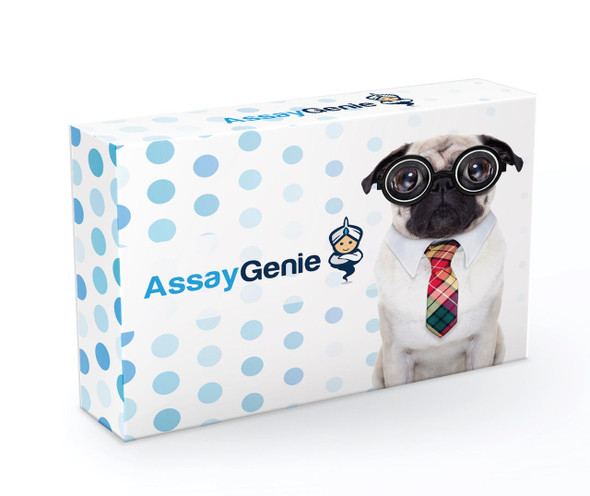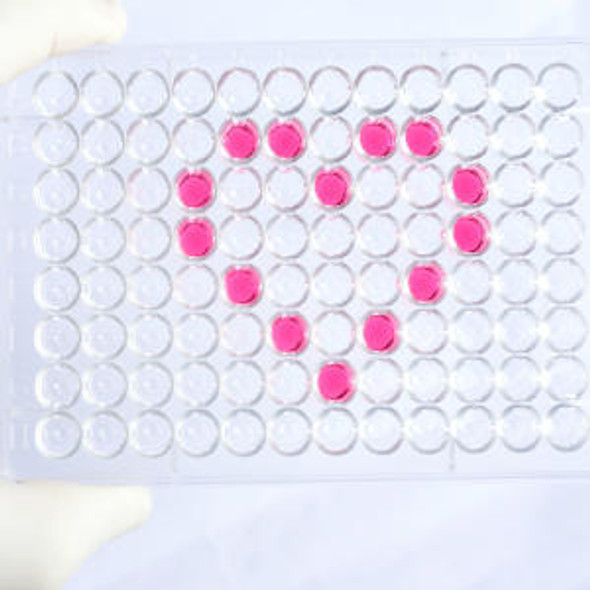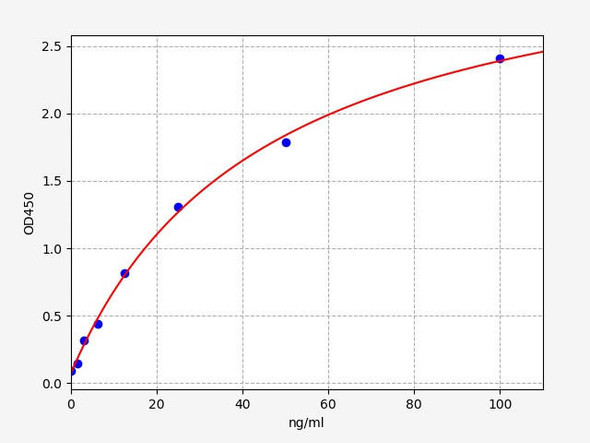Rat Cell Biology ELISA Kits 1
Rat Angiotensinogen (Agt) ELISA Kit
- SKU:
- RTEB0459
- Product Type:
- ELISA Kit
- Size:
- 96 Assays
- Uniprot:
- P01015
- Range:
- 15.6-1000 pg/mL
- ELISA Type:
- Sandwich
- Synonyms:
- ANG II
- Reactivity:
- Rat
Description
| Product Name: | Rat Angiotensinogen (Agt) ELISA Kit |
| Product Code: | RTEB0459 |
| Alias: | Angiotensinogen, Serpin A8, Agt, Serpina8 |
| Uniprot: | P01015 |
| Reactivity: | Rat |
| Range: | 15.6-1000 pg/mL |
| Detection Method: | Sandwich |
| Size: | 96 Assay |
| Storage: | Please see kit components below for exact storage details |
| Note: | For research use only |
| UniProt Protein Function: | angiotensin: Essential component of the renin-angiotensin system (RAS), a potent regulator of blood pressure, body fluid and electrolyte homeostasis. In response to lowered blood pressure, the enzyme renin cleaves angiotensinogen to produce angiotensin-1 (angiotensin 1-10). Angiotensin-1 is a substrate of ACE (angiotensin converting enzyme) that removes a dipeptide to yield the physiologically active peptide angiotensin-2 (angiotensin 1- 8). Angiotensin-1 and angiotensin-2 can be further processed to generate angiotensin-3 (angiotensin 2-8), angiotensin-4 (angiotensin 3-8). Angiotensin 1-7 is cleaved from angiotensin-2 by ACE2 or from angiotensin-1 by MME (neprilysin). Angiotensin 1-9 is cleaved from angiotensin-1 by ACE2. Genetic variations in AGT are a cause of susceptibility to essential hypertension (EHT). Essential hypertension is a condition in which blood pressure is consistently higher than normal with no identifiable cause. Defects in AGT are a cause of renal tubular dysgenesis (RTD). RTD is an autosomal recessive severe disorder of renal tubular development characterized by persistent fetal anuria and perinatal death, probably due to pulmonary hypoplasia from early-onset oligohydramnios (the Potter phenotype). Belongs to the serpin family. |
| UniProt Protein Details: | Protein type:Secreted, signal peptide; Secreted Chromosomal Location of Human Ortholog: 1q42.2 Cellular Component: extracellular space; cytoplasm; extracellular region Molecular Function:serine-type endopeptidase inhibitor activity; protein binding; growth factor activity; sodium channel regulator activity; hormone activity; type 2 angiotensin receptor binding; superoxide-generating NADPH oxidase activator activity; type 1 angiotensin receptor binding Biological Process: renal system process; extracellular matrix organization and biogenesis; positive regulation of nitric oxide biosynthetic process; establishment of blood-nerve barrier; negative regulation of nerve growth factor receptor signaling pathway; positive regulation of transcription, DNA-dependent; stress-activated MAPK cascade; female pregnancy; positive regulation of multicellular organism growth; positive regulation of vasodilation; activation of NF-kappaB transcription factor; ovarian follicle rupture; positive regulation of fibroblast proliferation; cell-cell signaling; positive regulation of superoxide release; negative regulation of neuron apoptosis; kidney development; positive regulation of NAD(P)H oxidase activity; positive regulation of cytokine production; angiotensin mediated regulation of renal output; response to muscle activity involved in regulation of muscle adaptation; regulation of calcium ion transport; regulation of norepinephrine secretion; negative regulation of tissue remodeling; positive regulation of phosphoinositide 3-kinase cascade; positive regulation of peptidyl-tyrosine phosphorylation; phospholipase C activation; angiotensin mediated vasoconstriction involved in regulation of systemic arterial blood pressure; regulation of vasoconstriction; regulation of transmission of nerve impulse; G-protein signaling, coupled to IP3 second messenger (phospholipase C activating); smooth muscle cell differentiation; cytokine secretion; nitric oxide mediated signal transduction; regulation of long-term neuronal synaptic plasticity; peristalsis; cell-matrix adhesion; renin-angiotensin regulation of aldosterone production; positive regulation of cellular protein metabolic process; smooth muscle cell proliferation; cellular lipid metabolic process; excretion; angiotensin maturation; vasodilation; response to salt stress; negative regulation of cell proliferation; positive regulation of MAPKKK cascade; fibroblast proliferation; renin-angiotensin regulation of blood vessel size; regulation of blood pressure; positive regulation of epidermal growth factor receptor signaling pathway; renin-angiotensin regulation of blood volume; regulation of cell growth; angiotensin mediated drinking behavior; artery smooth muscle contraction; aging; positive regulation of fatty acid biosynthetic process; blood vessel development; cellular sodium ion homeostasis; renal response to blood flow during renin-angiotensin regulation of systemic arterial blood pressure; activation of NF-kappaB-inducing kinase; positive regulation of peptidyl-serine phosphorylation; positive regulation of organ growth; regulation of cell proliferation; G-protein coupled receptor protein signaling pathway; negative regulation of angiogenesis; cellular protein metabolic process; ureteric bud branching; G-protein signaling, coupled to cGMP nucleotide second messenger; blood vessel remodeling; negative regulation of cell growth; response to cold; astrocyte activation; positive regulation of inflammatory response Disease: Renal Tubular Dysgenesis; Hypertension, Essential |
| NCBI Summary: | plays a role in regulation of blood pressure [RGD, Feb 2006] |
| UniProt Code: | P01015 |
| NCBI GenInfo Identifier: | 19705570 |
| NCBI Gene ID: | 24179 |
| NCBI Accession: | NP_602308.1 |
| UniProt Secondary Accession: | P01015,Q16358, Q16359, Q96F91, |
| UniProt Related Accession: | P01015 |
| Molecular Weight: | ~61-65,000 |
| NCBI Full Name: | angiotensinogen |
| NCBI Synonym Full Names: | angiotensinogen (serpin peptidase inhibitor, clade A, member 8) |
| NCBI Official Symbol: | Agt |
| NCBI Official Synonym Symbols: | Ang; PAT; ANRT; AngII |
| NCBI Protein Information: | angiotensinogen; serpin A8; angiotensin II; angiotensinogen (PAT) |
| UniProt Protein Name: | Angiotensinogen |
| UniProt Synonym Protein Names: | Serpin A8Cleaved into the following 8 chains:Angiotensin-1Alternative name(s):Angiotensin 1-10; Angiotensin I; Ang I |
| Protein Family: | Angiotensinogen |
| UniProt Gene Name: | AGT |
| UniProt Entry Name: | ANGT_HUMAN |
| Component | Quantity (96 Assays) | Storage |
| ELISA Microplate (Dismountable) | 8×12 strips | -20°C |
| Lyophilized Standard | 2 | -20°C |
| Sample Diluent | 20ml | -20°C |
| Assay Diluent A | 10mL | -20°C |
| Assay Diluent B | 10mL | -20°C |
| Detection Reagent A | 120µL | -20°C |
| Detection Reagent B | 120µL | -20°C |
| Wash Buffer | 30mL | 4°C |
| Substrate | 10mL | 4°C |
| Stop Solution | 10mL | 4°C |
| Plate Sealer | 5 | - |
Other materials and equipment required:
- Microplate reader with 450 nm wavelength filter
- Multichannel Pipette, Pipette, microcentrifuge tubes and disposable pipette tips
- Incubator
- Deionized or distilled water
- Absorbent paper
- Buffer resevoir
*Note: The below protocol is a sample protocol. Protocols are specific to each batch/lot. For the correct instructions please follow the protocol included in your kit.
Allow all reagents to reach room temperature (Please do not dissolve the reagents at 37°C directly). All the reagents should be mixed thoroughly by gently swirling before pipetting. Avoid foaming. Keep appropriate numbers of strips for 1 experiment and remove extra strips from microtiter plate. Removed strips should be resealed and stored at -20°C until the kits expiry date. Prepare all reagents, working standards and samples as directed in the previous sections. Please predict the concentration before assaying. If values for these are not within the range of the standard curve, users must determine the optimal sample dilutions for their experiments. We recommend running all samples in duplicate.
| Step | |
| 1. | Add Sample: Add 100µL of Standard, Blank, or Sample per well. The blank well is added with Sample diluent. Solutions are added to the bottom of micro ELISA plate well, avoid inside wall touching and foaming as possible. Mix it gently. Cover the plate with sealer we provided. Incubate for 120 minutes at 37°C. |
| 2. | Remove the liquid from each well, don't wash. Add 100µL of Detection Reagent A working solution to each well. Cover with the Plate sealer. Gently tap the plate to ensure thorough mixing. Incubate for 1 hour at 37°C. Note: if Detection Reagent A appears cloudy warm to room temperature until solution is uniform. |
| 3. | Aspirate each well and wash, repeating the process three times. Wash by filling each well with Wash Buffer (approximately 400µL) (a squirt bottle, multi-channel pipette,manifold dispenser or automated washer are needed). Complete removal of liquid at each step is essential. After the last wash, completely remove remaining Wash Buffer by aspirating or decanting. Invert the plate and pat it against thick clean absorbent paper. |
| 4. | Add 100µL of Detection Reagent B working solution to each well. Cover with the Plate sealer. Incubate for 60 minutes at 37°C. |
| 5. | Repeat the wash process for five times as conducted in step 3. |
| 6. | Add 90µL of Substrate Solution to each well. Cover with a new Plate sealer and incubate for 10-20 minutes at 37°C. Protect the plate from light. The reaction time can be shortened or extended according to the actual color change, but this should not exceed more than 30 minutes. When apparent gradient appears in standard wells, user should terminatethe reaction. |
| 7. | Add 50µL of Stop Solution to each well. If color change does not appear uniform, gently tap the plate to ensure thorough mixing. |
| 8. | Determine the optical density (OD value) of each well at once, using a micro-plate reader set to 450 nm. User should open the micro-plate reader in advance, preheat the instrument, and set the testing parameters. |
| 9. | After experiment, store all reagents according to the specified storage temperature respectively until their expiry. |
When carrying out an ELISA assay it is important to prepare your samples in order to achieve the best possible results. Below we have a list of procedures for the preparation of samples for different sample types.
| Sample Type | Protocol |
| Serum | If using serum separator tubes, allow samples to clot for 30 minutes at room temperature. Centrifuge for 10 minutes at 1,000x g. Collect the serum fraction and assay promptly or aliquot and store the samples at -80°C. Avoid multiple freeze-thaw cycles. If serum separator tubes are not being used, allow samples to clot overnight at 2-8°C. Centrifuge for 10 minutes at 1,000x g. Remove serum and assay promptly or aliquot and store the samples at -80°C. Avoid multiple freeze-thaw cycles. |
| Plasma | Collect plasma using EDTA or heparin as an anticoagulant. Centrifuge samples at 4°C for 15 mins at 1000 × g within 30 mins of collection. Collect the plasma fraction and assay promptly or aliquot and store the samples at -80°C. Avoid multiple freeze-thaw cycles. Note: Over haemolysed samples are not suitable for use with this kit. |
| Urine & Cerebrospinal Fluid | Collect the urine (mid-stream) in a sterile container, centrifuge for 20 mins at 2000-3000 rpm. Remove supernatant and assay immediately. If any precipitation is detected, repeat the centrifugation step. A similar protocol can be used for cerebrospinal fluid. |
| Cell culture supernatant | Collect the cell culture media by pipette, followed by centrifugation at 4°C for 20 mins at 1500 rpm. Collect the clear supernatant and assay immediately. |
| Cell lysates | Solubilize cells in lysis buffer and allow to sit on ice for 30 minutes. Centrifuge tubes at 14,000 x g for 5 minutes to remove insoluble material. Aliquot the supernatant into a new tube and discard the remaining whole cell extract. Quantify total protein concentration using a total protein assay. Assay immediately or aliquot and store at ≤ -20 °C. |
| Tissue homogenates | The preparation of tissue homogenates will vary depending upon tissue type. Rinse tissue with 1X PBS to remove excess blood & homogenize in 20ml of 1X PBS (including protease inhibitors) and store overnight at ≤ -20°C. Two freeze-thaw cycles are required to break the cell membranes. To further disrupt the cell membranes you can sonicate the samples. Centrifuge homogenates for 5 mins at 5000xg. Remove the supernatant and assay immediately or aliquot and store at -20°C or -80°C. |
| Tissue lysates | Rinse tissue with PBS, cut into 1-2 mm pieces, and homogenize with a tissue homogenizer in PBS. Add an equal volume of RIPA buffer containing protease inhibitors and lyse tissues at room temperature for 30 minutes with gentle agitation. Centrifuge to remove debris. Quantify total protein concentration using a total protein assay. Assay immediately or aliquot and store at ≤ -20 °C. |
| Breast Milk | Collect milk samples and centrifuge at 10,000 x g for 60 min at 4°C. Aliquot the supernatant and assay. For long term use, store samples at -80°C. Minimize freeze/thaw cycles. |






